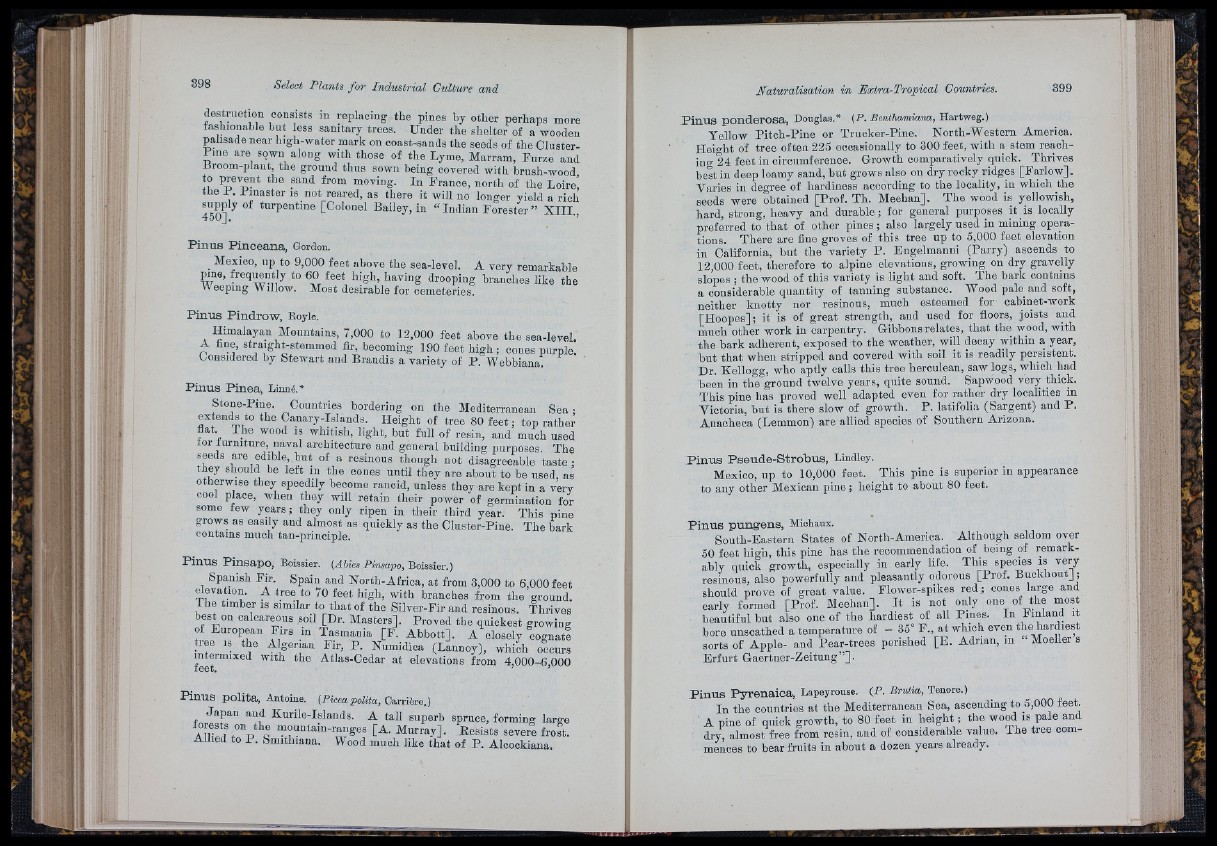
destructmn consists in replacing the pines by otlier perhaps more
fashionable bnt less sanitary trees. Under the shelter of a wooden
pahsade near high-water mark on coast-sands the seeds of the Cluster-
Pine are sown along with those of the Lyme, Marram, Furze and
Broom-plant, the ground thus sown being covered with brush-wood
to prevent the sand from moving. In France, north of the Loire,
the I Pinaster is not reared, as there it will no longer yield a rich
supply of turpentine [Colonel Bailey, in “ Indian Forester ” X I I I .,
P in u s P in c e a n a , Gordon.
Mexico, up to 9,000 feet above the sea-level. A very remarkable
pine, frequently to 60 feet high, having drooping branches like the
Weeping Willow. Most desirable for cemeteries.
P in u s P in d row , Eoyle.
Himalayan Mountains, 7,000 to 12,000 feet above th e sea-level.
A fine, straight-stemmed fir, becoming 190 feet high ; cones purple.
Considered by Stewart and Brandis a variety of P . Webbiana.
P in u s P in e a , Linné.*
Stone-Pine. Countries bordering on the Mediterranean S e a ;
extends to the Canary-Islands. Height of tree 80 feet ; top rather
flat The wood is whitish, light, but full of resin, and much used
toi turmture, naval architecture and general building purposes. The
seeds are edible but of a resinous though not disagreeable ta s te ;
they should be left in the cones until they are about to be used as
otherwise they speedily become rancid, unless they are kept in a very
cool place, when they will retain their power of germination for
some few years; they only ripen in their third year. This pine
grows as easily and almost as quickly as the Cluster-Pine. The bark
contains much tan-priiiciple.
P in u s P in s a p o , Boissier. (dSies Pmsopo, Boissier.)
Spanish Fir. Spain and North-Africa, at from 3,000 to 6,000 feet
elevation. A tree to 70 feet high, with branches from the ground.
1 he timber is similar to th a t of the Silver-Fir and resinous. Thrives
best on calcareous soil [Dr. Masters]. Proved the quickest growing
of European Firs in Tasmania [F . Abbott]. A closely cognate
tiee IS the Algerian Fir, P . Numidica (Lannoy), which occurs
intermixed with the Atlas-Cedar at elevations from 4,000-6,000
I66t.
P in u s p o lita , Antoine. (Picea polita, Carrière.)
Japan and Kurile-Islaiids. A tall superb spruce, forming large
o [A. Murray]. Resists severe frost.
Allied to P . Smithiana. Wood much like th a t of P . Alcockiana.
P in u s p o n d e ro s a , Douglas.* (P. Benthamiana, TAaxtweg.)
Yellow Pitch-Pine or Trucker-Pine. North-Western America.
Height of tree often 225 occasionally to 300 feet, with a stem reaching
24 feet in circumference. Growth comparatively quick. Thrives
best in deep loamy sand, but grows also on dry rocky ridges [Farlow].
Varies in degree of hardiness according to the locality, in which the
seeds were obtained [Prof. Th. Meehan]. The wood is yellowish,
hard, strong, heavy and durable; for general purposes it is locally
preferred to th a t of other p in e s; also largely used in mining operations.
There are fine groves of this tree up to 5,000 feet elevation
in California, but the variety P . Engelmanni (Parry) ascends to
12,000 feet, therefore to alpine elevations, growing on dry gravelly
slopes ; the wood of this variety is light and soft. The bark contains
a considerable quantity of tanning substance. Wood pale and soft,
neither knotty nor resinous, much esteemed for cabinet-work
[Hoopes]; it is of great strength, and used for floors, joists and
much other work in carpentry. Gibbons relates, th a t the wood, with
the bark adherent, exposed to the weather, will decay within a. year,
bu t th a t when stripped and covered with soil it is readily persistent.
Dr. Kellogg, who aptly calls this tree herculean, saw logs, which had
been in the ground twelve years, quite sound. Sapwood very thick.
This pine has proved well adapted even for rather dry localities in
Victoria, but is there slow of growth. P. latifolia (Sargent) and P.
Anacheca (Lemmon) are allied species of Southern Arizona.
P in u s P s e u d e -S tro b u s , Lindley.
Mexico, up to 10,000 feet. This pine is superior in appearance
to any other Mexican pine ; height to about 80 feet.
P in u s pung-ens, Michaux.
South-Eastern States of North-America. Although seldom over
50 feet high, this pine has the recommendation of being of remarkably
quick growth, especially in early life. This species is ver^y
resinous, also powerfully and pleasantly odorous [Prof. B u ckhoutJ;
should prove of great value. Flower-spikes re d ; cones la,rge and
early formed [Prof. Meehan]. I t is not oniy one of the most
heautiful but also one of the hardiest of all Pines. In Finland it
bore unscathed a temperature of - 35° F., a t which even the hardiest
sorts of Apple- and Pear-trees perished [E . Adrian, in “ Moeller s
Erfu rt Gaertner-Zeitung”] .
P in u s P y re n a io a , Lapeyrousc. (P. Brutia, Tenore.)
In the countries at the Mediterranean Sea, ascending to 5,000 feet.
' A pine of quick growth, to 80 feet in height ; the wood is pale and
dry, almost free from resin, and of considerable value. The tree commences
to bear fruits in about a dozen years already.
■ i f f
éVfr'.